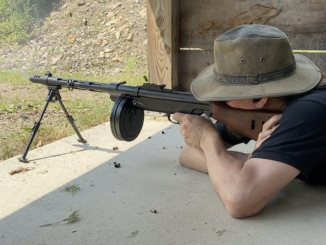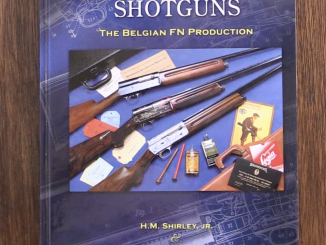This is Lot 1158 in the upcoming October Morphy Extraordinary auction.
Samuel McClean was a medical doctor from Iowa who began tinkering with firearms designs in 1889, and formed the McClean Arms Company in 1896. He was an intelligent and talented designer, but never quite managed to get a gun good enough for military acceptance. His work included bolt actions rifles, self-loading shoulder rifles, machine guns, and self-loading cannons. By 1910 his company had gone bankrupt twice, and he was forced out by his investors. Isaac Newton Lewis was brought in, and turned McClean’s initial concepts into the ultimately-successful Lewis Machine gun.
However, McClean made one least attempt to produce his own gun after World War One. This is the McClean Automatic Rifle, and it was tested by the US Navy in 1919 – and rejected. This pattern uses an operating system similar to McClean’s early work, and thus also quite similar to the Lewis gun. Instead of two large locking lugs, however, it has several dozen small lugs in two rows on each side of the bolt. The gas piston is also huge by modern standards; over an inch in diameter. The gun is unfortunately missing its magazine Still, it is the only example of the type known to exist, and probably the only one ever manufactured.




mono audio? or is it my PC?
nope, its the video
And then we have the patent problem with Lewis having to prove he didn’t steal the design. Ultimately the issue was settled out of court. The US Army Ordnance Corps still rejected everything not made in house with few exceptions like most guns made by John Browning. Judging from the attitude of the time, it appears some adopted the motto “once a failure, always a failure” to describe the prototype Lewis gun (after it self-destructed during testing). The predecessor gun linage was treated the same way.
I am surprised that this rifle wasn’t scrapped after rejection, but we get to look at the interesting story of how things developed. The design screams heavily of sitting on the fence between “what you’re used to using” and “brand new product, please read the manual.” Just kidding!
Uhm… but it was tested U.S. Navy, which already used Lewis machine guns see Use of the Lewis Gun by the Navy here: https://www.ibiblio.org/hyperwar/USN/ref/MG/I/MG-4.html#2
….large quantities were delivered to the Navy by 1 January 1918. From that date the Navy never suffered for lack of machine guns.
I would say that simply in 1919 there was not much demand for such weapons in general, rather than – with BAR in production, which could provide firepower in portable package and after all it was after end of Great War or as some dubbed it – war to end all war.
Hmm – full-pressure rifle cartridge, mid-length gas system, lawnmower-engine-size piston.
Unless the gas port was the diameter of a proton, I’m not sure how it didn’t destroy itself in one shot.
… unless he left large volume in front of piston for gas to expend into, which is a possibility. In early years it was a way how to get gas piston system working reliably; with great reserve of oomph.
At least the Hotchkiss machine guns didn’t kick themselves apart.
I agree with Denny (and caught / corrected myself in a post below). There looks to be a large volume forward of the in-battery piston position where gas can reach safe pressure before further expanding to drive it rearward.
You’ve go it! Boyle-Marriot theorem applies p x V = constant https://en.wikipedia.org/wiki/Boyle%27s_law
That’s right and that same gun (M1914) was the one I meant as a reference. Volume of gas compartment was large enough to soften pressure impulse and permitted regulation in wide range.
When we are at it, here is nice video with Hotchkiss M1914 https://www.youtube.com/watch?v=scebm0Y_cbU
what is remarkable how close to chamber that gas tap is. Also, at Oerlikon 20mm the gas tap is even closer; although it has slightly different purpose.
It looks as if Mad Max had designed a Lewis gun.
As shame it was deactivated in that way, by now it would surely be classed as a curio or relic.
I’m unclear on the legal status: since Ian said it wasn’t in the Registry, it doesn’t seem to be a DEWAT; on the other hand, it hardly seems destroyed enough to be considered a non-gun / parts kit.
In fact, while I’d hardly vouch for its safety (much less long-term endurance), it’s difficult to see anything that actually prevents it from firing?
On second viewing, I think I found the answer to my earlier question: there’s plenty of chamber volume forward of the piston to drop pressure to safe levels before it actually moves rearward.
That’s my kind of doctor – making incisions remotely 🙂
Magazine must have been important piece of study; it would reveal more ingenious thinking. Shame it is missing. The cut into receiver on the hand, is helpful to understand the action.
“(…)Magazine(…)”
I browsed through McClean patent and found Gas-actuated magazine-gun.
https://patents.google.com/patent/US785971A
from 1901, showing gas-operated shotgun with …magazine, preferably tubular in form and located beneath the barrel,…
For description of weapon showed in 2:56 see Patent US1042135A Automatic machine-gun.
https://patents.google.com/patent/US1042135A/en
(note than, back then machine gun term was applied both to machine guns in today sense and hand-cranked weapon, thence automatic make it clear)
This does not seem to fit with what we saw as presented by Ian today. The inventor had fertile imagination, that is for sure.
B.t.w. I want to say thanks for your patent search efforts.
That pump-action cocking system looks distinctly like the Standard self-loading sporting rifle.
cheers
eon
Interestingly McClean filled also patent for gas-operated automatic pistol yet in 1898:
https://patents.google.com/patent/US735131A/en
For me it looks more modern than average automatic pistols from 1898 – note magazine in grip and semi-rimmed cartridges.
What is that doo-hicky that appears to be BRAZED on the front left side of the receiver?
His 1898 pistol magazine is interesting, as the right grip panel is pivoted at the bottom. The shooter flips open the grip panel, lays or inserts the magazine in the opening, then closes the grip panel. I’ve never seen that method in any other example. He also shows his preference for knurling, on the barrel of this example.
Blimey.
a comment:
“….ultimately-successful Lewis machine gun” not so “ultimately” “successful”